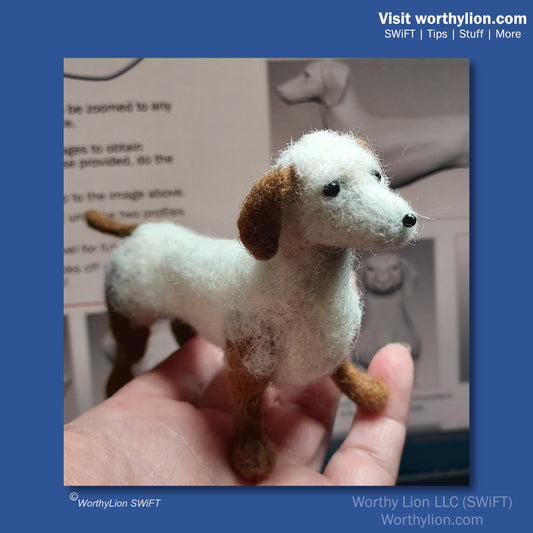Beginning sculptors
Practice in both clay and wool
 Learning is faster with repetition and the ability to trash something and start over easily. Needle felting is flexible and fixing errors is easy, but it can take time.
Learning is faster with repetition and the ability to trash something and start over easily. Needle felting is flexible and fixing errors is easy, but it can take time.
I suggest you get a one-pound block of cheap polymer clay (the kind you bake) and a set of cheap clay tools. Practice making basic shapes at first. Next, find pictures (reference images) of simple (cute) craft animals and recreate them, working your way up to more life-like critters.
Keep felting too. The beginning and starter projects in the SWiFT Handbook will get you started. You'll be surprised at how much the clay work improves your felting.
Stick to one topic
If you're looking to get good quickly, I suggest you pick an animal (and breed if needed) and make lots of them. Do studies (especially with clay) of the head, eye, nose, etc. Always work from reference images (always). Unless exceptionally talented, your memory isn't good enough.
Measure and compare
Problem-solve instead of judging your work. Look at your sculpture and then at your reference. What is different? Is the face too long? The nose is not shaped correctly? Keep comparing, measuring, and fixing until you're satisfied.
Measuring is so important to getting an accurate likeness! Even animals of the same breed have differences in nose size and shape, eye shape, and so on.
The SWiFT project sheets include measuring squares and guides to assist you. The 3D reference images can be zoomed to any size and used for measuring.
If you are creating the likeness of a specific animal you'll need to use its measurements - either directly from the animal or from a photo.


Rover won't look like Rover if the eyes are too small, too far apart, and the wrong shape. Or the ears, and nose are too big or too small. Wrinkles and gravity sags need to be the right size and shape. Measure everything!
Simplify!

Photos can be overwhelming with all the details they provide. The 3D sculpture images provided in the project sheets show only the details that are needed. You can supplement them with photos of carved or cast sculptures. There is a limit to how much detail a bronze or stone sculpture can show.
Using only these minimum details will allow you to focus on proportion and shape. The animal you create will still look good but may lack the subtle details that provide the realism you want.
Size plays a part. The larger the sculpture the more detail you can add.
As you gain experience, you’ll learn how, where, and when to add extra details.
Posing is soooooo important!

If the pose isn't realistic, you can sculpt a proportionally perfect model and it may still look wonky. The SWiFT handbook AND this Website have a section on posing. It explains (with pictures) that you need to find the flow of motion and to support the animal's weight.
Start Learning the SWiFT Way of Needle Felting
Download the Free SWiFT Handbook and Two Free Project Sheets Today! | USA only. International visitors, please visit http://www.worthylion.etsy.com
-
Free Starter Bundle to Download
Regular price $0.00 USDRegular priceUnit price / per -
203BRP-B | Cute Kitten
Regular price $5.00 USDRegular priceUnit price / per -
401BRP-B | Cute Lamb
Regular price $5.00 USDRegular priceUnit price / per -
Dog: 118B | Dachshund | Standing
Regular price $5.00 USDRegular priceUnit price / per -
Horse: 303b | Jumping | Portrait
Regular price $5.00 USDRegular priceUnit price / per -
Marine: 512B | Sea Turtle | Swimming
Regular price $5.00 USDRegular priceUnit price / per -
Cat: 201B | Common | Portrait
Regular price $5.00 USDRegular priceUnit price / per -
Dog: 101B | Lab-type | Pre-posed | Sitting
Regular price $5.00 USDRegular priceUnit price / per -
Horse: 302B | Portrait
Regular price $5.00 USDRegular priceUnit price / per -
Dog: 116B | Boxer | Standing
Regular price $5.00 USDRegular priceUnit price / per



















